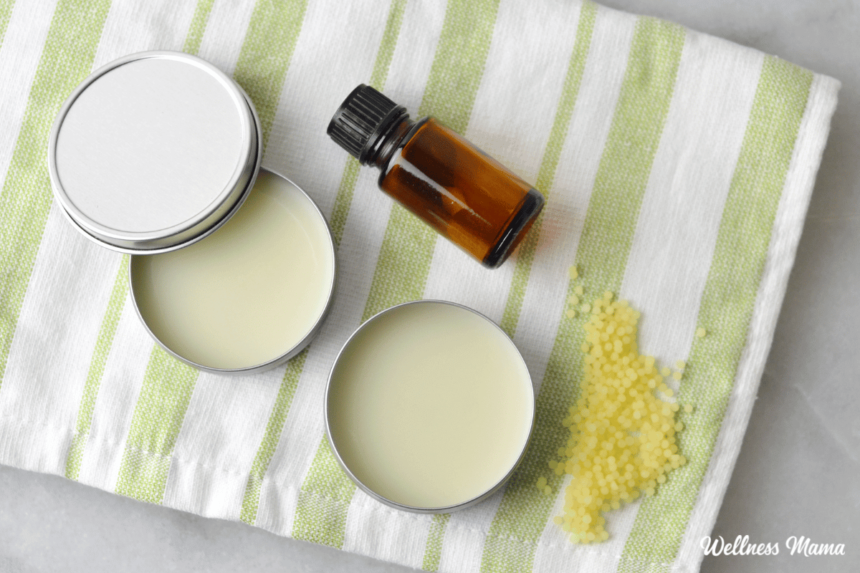It is hoped that cold and flu season will bypass your household this year. However, in case it does strike, having this natural vapor rub as a home remedy is a wise choice. Safe for both adults and children, this vapor rub is effective in relieving congestion!
In the past, I used to keep regular Vicks Vapor Rub and the baby version on hand for when the seasonal cold would hit. That was until I discovered that it contained PETROLEUM… not something I want to be putting on my children’s skin!
Since then, I have been making this easy homemade vapor rub to avoid slathering my children’s skin with something more suitable for a car engine. If you’re interested, you can learn more about the issues with petroleum jelly (Vaseline®) here.
How to Make a Natural Vapor Rub Alternative
The familiar blue bottle of vapor rub was a staple in my house when I was growing up. Now, as a parent, I understand its value. Treatment options for colds and coughs are limited for babies and kids, making vapor rub invaluable for soothing coughing and congestion that can disrupt everyone’s sleep.
Don’t be discouraged by the ingredient list for this recipe. If you don’t have all the necessary ingredients or prefer a quicker option, mixing essential oils with coconut oil can work almost as effectively!
Store-bought Chest Rub
Fortunately, since I started making my own natural products, more companies have released natural versions. I found a pre-made natural vapor rub for those who might not have the ingredients on hand. There’s even a formula designed specifically for babies and children.
If you’re lucky enough to have a Whole Foods or a natural health store nearby, you might find natural vapor rub options there. Additionally, several good natural vapor rub options are available on Amazon.
Essential Oil Vapor Rub Safety
When making this for babies or young children, make sure to use essential oils that are safe for their age. Safety is crucial when using essential oils, and I recommend erring on the side of caution. I particularly like this kid-safe line of essential oils as it takes the guesswork out of choosing the correct oils. The Sniffle Stopper blend is most similar to the blend used in this recipe.
Sometimes, I create a gentler kid-safe version of this recipe by using only 4 drops of eucalyptus and fir oils and omitting the rest. Below is a list of all the essential oils used, their purposes, and safety precautions. Additional safety notes can be found below the recipe.
Essential Oils for Vapor Rub
- Eucalyptus – Both E. Radiata and E. Globulus are popular chemotypes. Radiata is a bit gentler, but it’s listed as near threatened, so it’s important to buy from a reputable grower. Both are considered safe for diluted topical use on children ages 3 and up. Avoid applying eucalyptus to the face or sinus area of young children as it can cause breathing issues.
- Peppermint oil – Like eucalyptus, peppermint contains 1,8 cineole, which can cause breathing issues in young children if not used properly. It’s considered safe to use a .5% dilution (not on the face) for children ages 3 and up. Adults can use up to 5% topically, depending on the use. This recipe keeps it at less than 1% for older children and adults, and less than .5% for children aged 3-6. Peppermint is about 50% menthol, making it great for stuffy noses.
- Rosemary – This oil is a bit harsher on little ones compared to others. It’s high in camphor, which makes it good for circulation and congestion. It’s a safe decongestant for ages 7 and up, with a recommended maximum dilution of 4% for kids (up to 16% for adults). I omit this oil when making a homemade vapor rub for young children.
- Cinnamon leaf – Note that this is NOT cinnamon bark! Cinnamon leaf is gentler on the skin and excellent for the immune system. It’s slightly warming and, according to Tisserand and Young, it’s safe for topical use with infants aged 3 months and up. Cinnamon bark poses a high risk of skin irritation, can only be used topically in tiny amounts, and is not safe for children. Personally, I avoid using this oil with young kids.
- Clove – Sometimes, I substitute clove for cinnamon leaf in this chest rub recipe. It can be used on children aged 3 and older in certain situations, but it’s not the gentlest option. I prefer to omit this oil for young children.
Baby Vapor Rub Essential Oils
- Fir – Douglas fir or fir needle are gentle options that work well in a DIY vapor rub. They support the respiratory system and are generally safe for infants aged 3 months and older when properly diluted.
- Cedarwood (Virginian) – This woodsy-smelling oil is great in men’s lotion but also perfect in home remedies for coughs and relaxation.
- Lavender – Like tea tree oil, lavender has soothing properties for the skin. It also contains monoterpenes, making it beneficial for respiratory support.
Natural Vapor Rub Recipe
A soothing and petroleum-free version of the classic over-the-counter cough and cold vapor rub.
Yield: 5 ounces
Baby Vapor Rub (6 months and up)
-
Melt beeswax with your carrier oil of choice in a double boiler just until melted. You can also use a heat safe glass bowl on top of a small pot.
-
Turn off the heat and stir in the essential oils.
-
Stir until well mixed and pour into a container with a lid to store. Small tins work well, as does a glass jar.
-
Allow the vapor rub to cool completely and harden.
-
Use as needed to reduce coughing and congestion. See safety information in article.
Safety Notes
Many essential oils, including some used in this recipe, are not considered safe for babies or young children. Always dilute essential oils for babies and children, and use them sparingly. The natural vapor rub recipe is safe for ages 3 and up with the necessary modifications outlined in the recipe. For a gentler option, you can apply the vapor rub to the soles of children’s feet (ages 3-6).
The baby-safe vapor rub version maintains a dilution of .5% and uses gentler oils. Experts generally consider these oils and this dilution safe for babies aged 6 months and up. You can also halve the amount and use 2 drops of each essential oil if desired.
Always consult a qualified healthcare provider before using herbs or essential oils on young children.
You can also create this recipe with herbs instead of essential oils by infusing the oil with 1 tablespoon of each herb in a double boiler over medium heat for 2 hours.
This article was medically reviewed by Dr. Lauren Jefferis, board certified in Internal Medicine and Pediatrics. As always, this is not personal medical advice and we recommend that you talk with your doctor.
What are your tried and true remedies for beating congestion and cough? Have you ever made your own vapor rub? Share your experiences below!
- Tisserand, R., & Young, R. (2013). Essential Oil Safety (2nd ed.). Churchill Livingstone.
- Fensham, R., Laffineur, B. & Collingwood, T. (2019). Eucalyptus radiata. The IUCN Red List of Threatened Species 2019: e.T133374163A133
Source link





